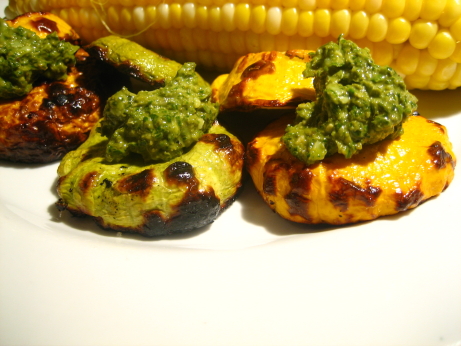I’m so happy I made this pesto. I went up to the market, and paid a nice lady twelve dollars for an enormous bucket full of perfectly fresh and amazingly fragrant basil. I got my bounty home and I was ready to go into industrial pesto production mode. Unfortunately I’d forgotten that a bushel of basil was going to require a lot more pine nuts than I had on hand to turn into pesto. My neighborhood isn’t lacking for bulk food stores, but it would seem everyone else had the same weekend project as I did. There wasn’t a pine nut to be had, except at the mysteriously overpriced store-of-last-resort. My precious basil was wilting on the counter at home, so I sucked it up and paid saffron prices for my pine nuts.
I got home, and I was finally ready to start. But I discovered that my beloved food processor had died on me. I use an inherited Robot Coupe processor, that has to be at least 25 years old. It’s a little the worse for wear, but it’s always worked perfectly. I love its simplicity, only one blade, and a switch, controlling pulse and stay on modes, that’s it. It has a very solid motor, a decent sized bowl, and no superfluous gimmicks. I wasn’t ready to give up on my workhorse of a processor just yet, so I did a little jury rigging. After disabling the safety feature that prevents the blade from spinning without the top on with the eraser off the back of a pencil I was good to go. I’m convinced that I’ll lose a finger to the machine, and I’m mildly terrified of it, but I’m keeping it for now.
Thankfully I was able to get to the recipe without any further setbacks. The pesto is very straightforward, and much like every other food processor pesto recipe in the world. You add garlic to the running processor, then add pine nuts, Parmigiano-Reggiano, salt, pepper, and basil leaves, then chop it up and add olive oil in a slow stream with the motor running ’till it’s nearly smooth.
I planned on freezing most of my pesto so I omitted the cheese (as per the recipes recommendation), and froze the pesto in ice cube trays. I now have two big Ziplock bags full of pesto in the freezer. I’ve been making giant batches of pesto for the last few years and I absolutely love having it on hand. It’s an integral ingredient in my pizza sauces, and I think of it as a security blanket for uninspired nights when I need to cook quickly. I just toss pasta with a cube of pesto, and a bit of pasta water, top with grated Parmigiano-Reggiano and black pepper and I’m eating within 20 minutes.
If you’re planning on making pesto ice cubes I’d recommend going to to dollar store and getting a separate set of ice cube trays for the purpose. I used our everyday trays, and despite a thorough wash is hot soapy water I could swear my G&T tasted of basil.
This is a very standard, solid pesto recipe, it goes a little heavy on the oil, but is otherwise great. It’s actually a bit hard to know if I followed the recipe properly. It calls for 3 cups of loosely packed fresh basil leaves, but what exactly does that mean? I know we North Americans like our recipes in cups and spoonfuls, but in this case a weight measurement for a dry ingredient wouldn’t kill them. I’ll happily convert ounces to decent metric units, but please give me a halfway precise estimate of how much basil this recipe calls for.
I’m very happy with the way this pesto turned out, it freezes wonderfully, and I’ve been enjoying it a little at a time. Right now it’s just a nice treat, but by mid-February having summer-fresh pesto on hand is going to be a critical weapon in the fight against the bleak winter dreariness. I’d highly recommend that everyone devote one day in late summer to making a giant batch of pesto, and enjoying the fruits of your labour all winter long.
